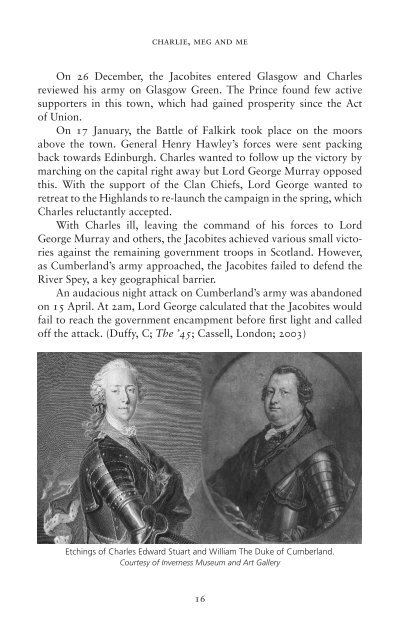Charlie, Meg and Me by Gregor Ewing sampler
Charlie: Prince Charles Edward Stuart, second Jacobite pretender to the thrones of England, Scotland and Ireland, instigator of the Jacobite uprising of 1745, fugitive with a price of £30,000 on his head following the disaster of Culloden, romantic figure of heroic failure. Meg: My faithful, four-legged companion, carrier of supplies, listener of my woes, possessor of my only towel. Me: An ordinary guy from Falkirk only just on the right side of 40, the only man in a houseful of women, with a thirst for a big adventure, craving an escape from everyday life. For the first time, Bonnie Prince Charlie’s arduous escape of 1746 has been recreated in a single journey. The author, along with his faithful border collie Meg, retraces Charlie’s epic 530 mile walk through remote wilderness, hidden glens, modern day roads and uninhabited islands.
Charlie: Prince Charles Edward Stuart, second Jacobite pretender to the thrones of England, Scotland and Ireland, instigator of the Jacobite uprising of 1745, fugitive with a price of £30,000 on his head following the disaster of Culloden, romantic figure of heroic failure.
Meg: My faithful, four-legged companion, carrier of supplies, listener of my woes, possessor of my only towel.
Me: An ordinary guy from Falkirk only just on the right side of 40, the only man in a houseful of women, with a thirst for a big adventure, craving an escape from everyday life.
For the first time, Bonnie Prince Charlie’s arduous escape of 1746 has been recreated in a single journey. The author, along with his faithful border collie Meg, retraces Charlie’s epic 530 mile walk through remote wilderness, hidden glens, modern day roads and uninhabited islands.
You also want an ePaper? Increase the reach of your titles
YUMPU automatically turns print PDFs into web optimized ePapers that Google loves.
charlie, meg <strong>and</strong> me<br />
On 26 December, the Jacobites entered Glasgow <strong>and</strong> Charles<br />
revi e wed his army on Glasgow Green. The Prince found few active<br />
supporters in this town, which had gained prosperity since the Act<br />
of Union.<br />
On 17 January, the Battle of Falkirk took place on the moors<br />
above the town. General Henry Hawley’s forces were sent packing<br />
back towards Edinburgh. Charles wanted to follow up the victory <strong>by</strong><br />
marching on the capital right away but Lord George Murray opposed<br />
this. With the support of the Clan Chiefs, Lord George wanted to<br />
retreat to the Highl<strong>and</strong>s to re-launch the campaign in the spring, which<br />
Charles reluctantly accepted.<br />
With Charles ill, leaving the comm<strong>and</strong> of his forces to Lord<br />
George Murray <strong>and</strong> others, the Jacobites achieved various small victories<br />
against the remaining government troops in Scotl<strong>and</strong>. However,<br />
as Cumberl<strong>and</strong>’s army approached, the Jacobites failed to defend the<br />
River Spey, a key geographical barrier.<br />
An audacious night attack on Cumberl<strong>and</strong>’s army was ab<strong>and</strong>oned<br />
on 15 April. At 2am, Lord George calculated that the Jacobites would<br />
fail to reach the government encampment before first light <strong>and</strong> called<br />
off the attack. (Duffy, C; The ’45; Cassell, London; 2003)<br />
Etchings of Charles Edward Stuart <strong>and</strong> William The Duke of Cumberl<strong>and</strong>.<br />
Courtesy of Inverness Museum <strong>and</strong> Art Gallery<br />
16


















